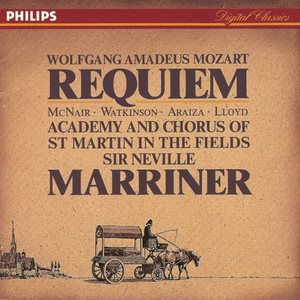Born in Salzburg, then in the Holy Roman Empire and currently in Austria, Mozart showed prodigious ability from his earliest childhood. Already competent on keyboard and violin, he composed from the age of five and performed before European royalty. His father took him on a grand tour of Europe and then three trips to Italy. At 17, he was a musician at the Salzburg court but grew restless and traveled in search of a better position.
While visiting Vienna in 1781, Mozart was dismissed from his Salzburg position. He stayed in Vienna, where he achieved fame but little financial security. During his final years there, he composed many of his best-known symphonies, concertos, and operas. His Requiem was largely unfinished by the time of his death at the age of 35, the circumstances of which are uncertain and much mythologized.
Domine Jesu
Wolfgang Amadeus Mozart Lyrics
Jump to: Overall Meaning ↴ Line by Line Meaning ↴
libera animas omnium fidelium defunctorum
de poenis inferni
et de profundo lacu.
Libera eas de ore leonis
ne absorbeat eas tartarus,
ne cadant in obscurum;
Sed signifer sanctus Michael
Quam olim Abrahae promisisti
et semini eius.
The lyrics to Mozart's song Domine Jesu are a plea to Jesus Christ, the King of Glory, to free the souls of all departed faithful believers from the pains of hell and the deep abyss. It implores that they be saved from the lion's mouth and the dark abyss, and instead be led into the holy light that was promised to Abraham and his descendants. The song makes reference to the archangel Michael, who is known in Christian theology as the leader of the army of God against Satan and his demons. The archangel is believed to be the guardian and protector of the faithful in times of battle and harm.
The lyrics reflect a deep sense of religious and spiritual devotion, and they speak to the fear and uncertainty that many people feel when faced with the idea of death and what may come after. The song exudes a sense of hope that even in death, one's soul can find redemption and salvation through the mercy of Jesus Christ. It is a powerful piece of music that has resonated with people for centuries.
Line by Line Meaning
Domine, Jesu Christe, Rex gloriae,
Lord Jesus Christ, King of glory,
libera animas omnium fidelium defunctorum
free the souls of all the faithful departed
de poenis inferni
from the punishments of hell
et de profundo lacu.
and from the deep pit.
Libera eas de ore leonis
Free them from the mouth of the lion,
ne absorbeat eas tartarus,
so that Tartarus may not swallow them
ne cadant in obscurum;
or they fall into darkness;
Sed signifer sanctus Michael
But may Michael, the holy standard-bearer,
repraesentet eas in lucem sanctam,
present them in the holy light
Quam olim Abrahae promisisti
which you promised to Abraham
et semini eius.
and his descendants.
Contributed by Carson J. Suggest a correction in the comments below.

@musical_pollybreed6438
(0:11)
You take a mortal man
And put him in control
Watch him become a God
Watch people's heads a-roll
A-roll
A-roll
Just like the pied piper
Led rats through the streets
We dance like marionettes
Swaying to the symphony of destruction
Acting like a robot
It's metal brain corrodes
You try to take its pulse
Before the head explodes
Explodes
Explodes
Argh
Just like the pied piper
Led rats through the streets
We dance like marionettes
Swaying to the symphony
Just like the pied piper
Led rats through the streets
We dance like marionettes
Swaying to the symphony
Swaying to the symphony of destruction
The Earth starts to rumble
World powers fall
A warring for the heavens
A peaceful man stands tall
A-tall
A-tall
Just like the pied piper
Led rats through the streets
We dance like marionettes
Swaying to the symphony
Just like the pied piper
Led rats through the streets
We dance like marionettes
Swaying to the symphony
Swaying to the symphony of destruction
@rangerwhiskeybreath4935
Today we are spoiled with music and media. But imagine seeing this in concert at the time, it must've been like standing before God on his throne in heaven!
@vigokovacic3488
Very well said and noticed.
@raginald7mars408
still now today voce Dei
@lysajsmrtihlav6549
Actually, this is sacred music. It's not written for concerts, but for liturgy, specifically funeral services. In Mozart's time, it was the norm to attend liturgy at least every Sunday, and the liturgy was accompanied by very fine music (even by today's standards). Arguably, the average person's exposure to quality classical music was far greater in Mozart's time than it is today.
@scholaroftheworldalternatehist
Go to church. Sounds better in person still
@supernivemdealbabor
It was not like standing before God in his Trhone in Heaven.
It is literally even today, as before and as always is going to be: standing before God on his altar.
This is performed at Catholic Masses not at concerts. In front of the unique and true Altare Dei.
@maximilianbjorklund6544
1:59 always gives me chills
@MaestraWashu
Same! The "Quam olim Abrahae" section might be my favorite bit of the entire Requiem.
@melcat713
SAME.
@thiagopezzini
pra mim a mesma coisa